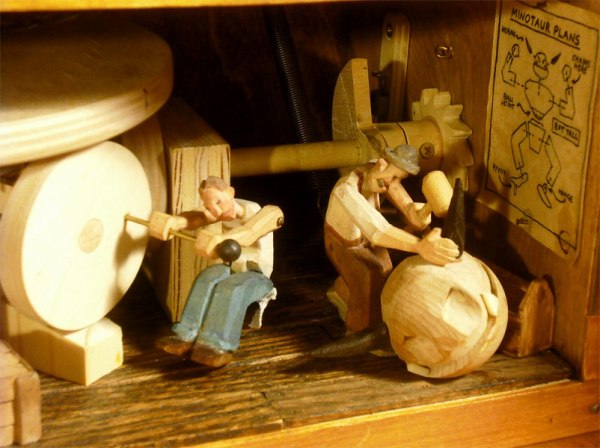Many automata move in a stiff and predictable way. I wanted to create a piece with a somewhat more organic motion. This piece was built up gradually around the monster figure. I started by giving the minotaur a ball-and-socket joint at his pelvis. I made him thrash about by tugging the chains strapped to his wrists with a mechanism below the figure. To my surprise, I found that a loose pivot under one foot would cause the monster to step forward. I am always on the lookout for happy accidents such as this. I hinged the monster’s jaw so that as it leans back his mouth flies open.
With the monster done, I needed a context for all of this thrashing and stomping. I could envision the monster pulling against a strongman figure, but how could I make the two figures seem connected? The answer: connect them! I found a length of braided cord with a hollow center and ran a piece of music wire down the middle. This wire connects the minotaur to the strongman, who is jointed something like a marionette. To the viewer, it seems like the strongman is tugging against the monster. In reality, the minotaur is driving all of the strongman’s motions. The motion transferred through the wire causes the strongman to quiver and hesitate in subtle ways. I never could have achieved these motions by trying to move the strongman directly.
The scene inside the box adds another level (literally and figuratively) to the piece. The idea is that the sideshow is a hoax designed to draw in the crowds and their money. The minotaur is a fake, driven by a hidden worker who is turning a crank below the stage. Beside him, another worker assembles a backup minotaur.
Finally, I added all of the little elements that set the scene — the backdrop, banners, flooring, tools, crate, barbells, stool, barrel, bucket, poster, ashtray, and beer bottles. A card game with three players was clearly in progress just before the show.
Creating this automaton was a long and difficult process. I am very happy with the finished piece.













